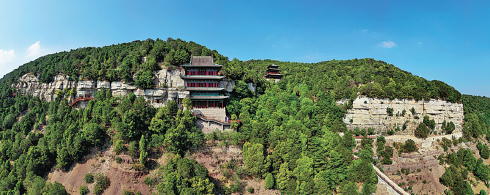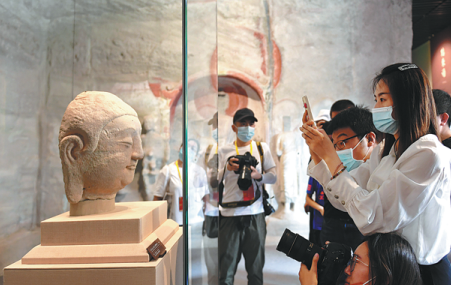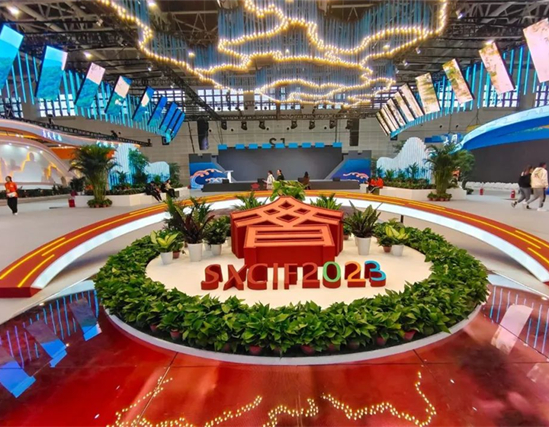Relic's return a highlight of major cultural rejuvenation
Updated: 2021-07-30

Located in the southwestern suburbs of Taiyuan, Tianlongshan Grottoes is a major site for ancient Buddhist arts in Shanxi province. [Photo by Sun Ruisheng/China Daily]
Buddha head back home after theft from Tianlongshan Grottoes almost a century ago
After seven months since its return to China, a stone Buddha head repatriated from Japan finally reached its home at Tianlongshan Grottoes, southwest of Taiyuan, capital city of Shanxi province, on July 24.
A grand ceremony to mark the return was held, attended by Lin Wu, Party secretary of Shanxi, and Li Qun, chief of the National Cultural Heritage Administration, as well as other officials and experts.
The stone head, stolen from one of the Buddha statues in Cave 8 of Tianlongshan Grottoes and smuggled to Japan nearly 100 years ago, was brought back to China on Dec 12, Xinhua News Agency quoted the NCHA as saying.
The administration first identified the Buddha head in September 2020, when the sculpture resurfaced at a Japanese auction house.
After identifying it, the NCHA contacted the auction house and requested a halt to the sale.
Luckily, Zhang Rong, board chairman of the auction house, is a Chinese national. In late October, after buying the Buddha head from a Japanese collector, Zhang donated the sculpture to the Chinese government, Xinhua reported.
Examinations and evaluations conducted by experts after the sculpture arrived in Beijing in December found that the relic had been stolen from a statue in Cave 8 of the grottoes around the year 1924.
To welcome its return, a special exhibition opened on July 24 in the Tianlongshan Grottoes Museum to review its history through cultural relics, pictures, digitization and 3D-printing technology.
Two exhibition halls have been dedicated to the show. One hall uses 3D-printing, virtual reality and artificial intelligence to show how the cave was dug and how the statue was built more than a millennium ago.
Another hall, a scale replica of Cave 8, houses the returned sculpture. The stone head will not be placed on the original body because of weathering and water erosion, said an official at the museum. The head will be permanently displayed at the museum. Other relics from Tianlongshan Grottoes are also exhibited in the hall.
"The Buddha head on display reminds me of a reunion with a long-lost family member," said Yu Hao, curator of the museum.
In the 1920s, a large number of statues-more than 240, according to Yu-were stolen from the grottoes and smuggled overseas. About 150 statues are housed in museums in Japan, Europe and the United States, or have been obtained by foreign collectors. The whereabouts of the rest are unknown.
Zhang Rong, the businessman who purchased and donated the Buddha head, attended the returning ceremony, where he was named an "honorable resident of Taiyuan".
Zhang said, as a Chinese citizen, his action in helping to retrieve the sculpture was driven by patriotism and a strong sense of pride in the nation.

Visitors take photos of the returned Buddha head statue at the Tianlongshan Grottoes Museum. [Photo by Xu Xiaojian for China Daily]
On July 25, the day following the ceremony, the exhibition received more than 800 tourists who were eager to see this precious cultural relic.
"I finally have a chance to see the 'eternal smile' of the Buddha, which gives me a peace of mind," said Xu Kai, a visitor from Taiyuan.
Also on that day, Zheng Ya'nan, a tour guide at the museum, reminded visitors of the Buddha's smile and other artistic features of the statue, and told stories about the century long journey of the Buddha head.
Zheng said the Buddha statue in Cave 8 was built during the Tang Dynasty (618-907). Construction of the grottoes, consisting of 25 caves, began in the Eastern Wei Dynasty (534-550) and continued until the Tang Dynasty.
When describing the face of the Buddha, Zheng said: "Seen from every angle, the Buddha presents a smiling expression. This is a show of confidence identical to a prosperous period like the Tang Dynasty."
This 44.5-centimeter-high Buddha head is the first among stolen relics to be returned from Japan, according to NCHA chief Li Qun.
"The fate of cultural relics is linked to the destiny of a country," Li said at the return ceremony. "Its journey home reflects Chinese people's patriotism, no matter whether they live at home or abroad, and it marks the nation's rejuvenation."
Shanxi Party secretary Lin Wu said the return of the Buddha head is of great significance to Shanxi's cultural heritage protection.
He asked cultural heritage workers to devote more effort to the protection of and research on cultural relics, as such resources "can play an important role in teaching history and building a stronger province in culture".
Guo Yanjie contributed to this story.



